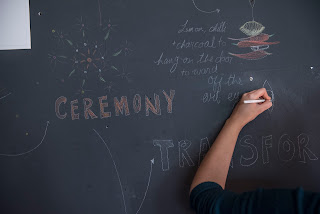On the last day of residence, though tired from
cumulative sleep depravation, I woke up even earlier than my 6 am routine. I prepared my ginger tea and headed to the library for my daily meditation before getting to work.
When I got there, I walked over to the exhibition space and lit a small candle at the altar. I decided to meditate right there, in front of all of my ancestors, in front of all of the stories and images.
Through the residence, I had been terrified of the responsibility of
telling my family's story.
I felt a bit intimidated, embarrassed even about sharing such intimate details of my life, of our lives
...diagrams of the building where I grew up, that tender memory of sitting on my grandfather's lap, anecdotes.
I was especially blocked with how to talk about death.
In chapter 3 of the book, when my grandfather Dada passes away,
the dynamic changes.
It is at this moment that Nani transforms into the super magical character who lives in her suitcase and travels to all of our homes, bringing ceremony and celebration with her.
I had thought that if I managed to finish Chapter 3 during residence, my process once I got back home would be easier.
I barely began the chapter on the last day of residence, when I realized that I could not rush it. And that more important than actually making the drawings, was all the previous work I had been doing which was helping me to reconcile not only with death, but with taking upon the role of being the family's memory.
I felt grateful.
Photos courtesy of CarlosGrassa Toro
La Cala de Chodes










































